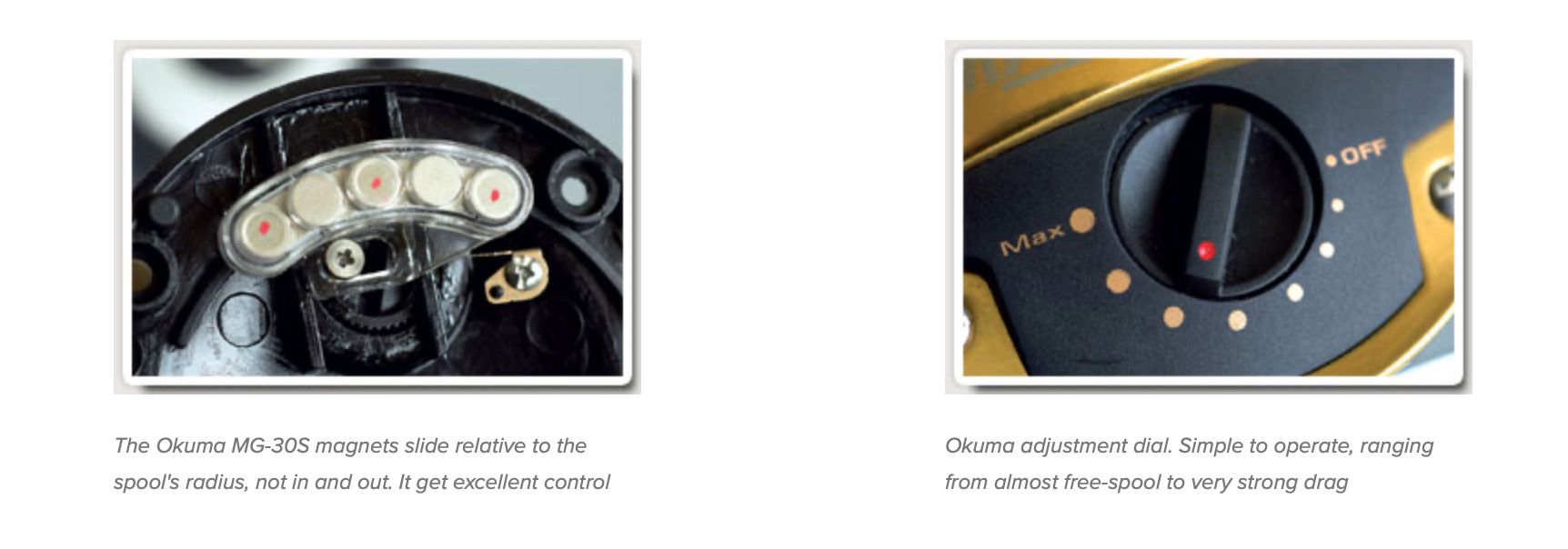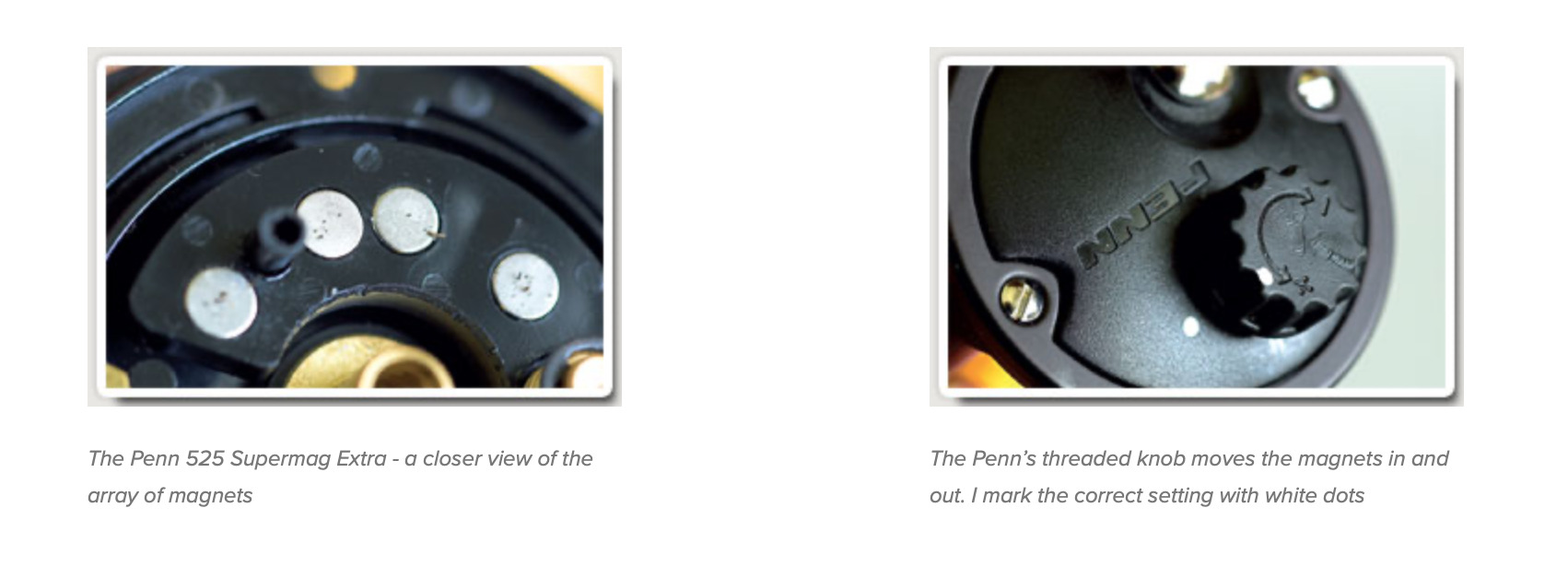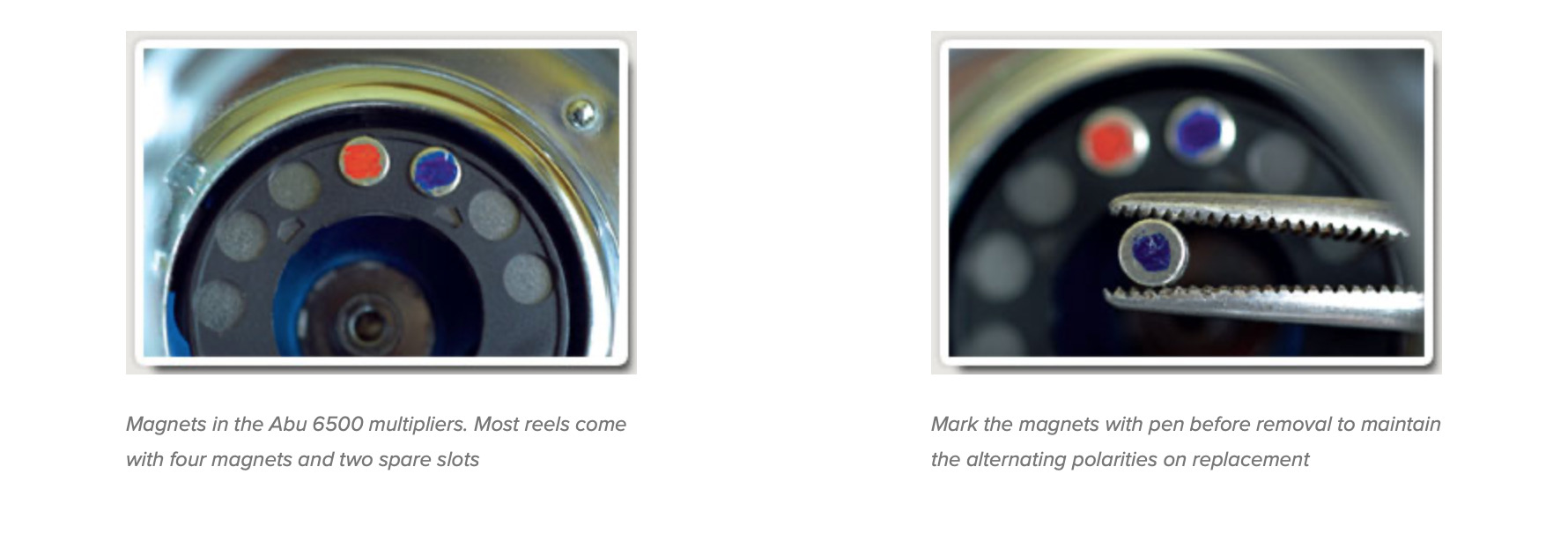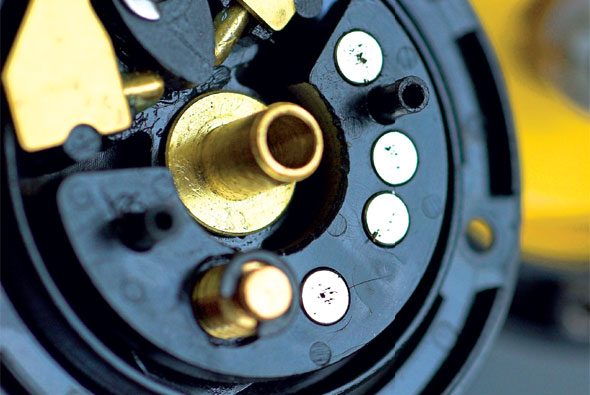Casting and tackle expert John Holden offers some really useful advice on getting the best from multiplier sea fishing reels with magnetic brakes…
A SURPRISING NUMBER OF anglers still refuse to believe that magnetic brakes actually work. A typical letter goes like this: “Mag control cannot operate unless a spool is made of steel, which would be useless for casting. Aluminium doesn’t stick to a magnet. Why do you people keep recommending them?”
Fixing a small but powerful magnet into a multiplier reel’s sideplate does help to control an alloy spool for casting. The principle is simple: when an electrical conductor passes through a magnetic field, its movement is resisted and the magnet acts as a brake. The vital word is conductor – not the familiar attraction that draws steel to a magnet.
Aluminium spools are excellent conductors, and that’s why magnetic brakes can be so useful and efficient. A slider or control knob alters the relationship between the magnet and the spool to produce the appropriate braking force. Adjustment takes only a moment, with no need to strip the reel and no brake blocks to fall out.
The original small Abu magnetic reels were targeted at baitcasting. The brake setup did not suit beach fishing, unless you played with the reel’s innards. My current Sports Mag 6500CT is so much better in this respect that modifying the brake is of no benefit for fishing. I set the slider to ‘3’ when the reel came out of the box, and that’s where it has stayed. The reel casts 4-6oz long or far under most conditions, and with almost full insurance against backlashes.
Like most small high-performance reels, the Mag’s zero setting is still a shade too resistant for casting on a field or fishing at extreme ranges.
First step is to remove one or two tiny magnets from the array. That’s easy: just pull them away from the steel backing plate where they are held by magnetic attraction. The magnetic elements within an array are usually arranged with alternately opposed poles (N-S-N, etc), so I always mark the front faces before taking them out so that they can be replaced in the correct order – not that it seems to make any difference to the brake’s performance.
With the magnetic field reduced the lead weight really flies, but the reel is more nervous. A nasty characteristic of all tuned magnetic systems is that a small movement of the slider or adjustment screw can make a big difference to speed and controllability. This is an inherent weakness of magnetic braking in general, not a bad reflection on any particular reel.
Best solution is to get the magnet setting more or less right, then fine-tune with oils. In the case of the small Abu reels fitted with centrifugal brakes as well as magnets, you could add maybe one small brake block.
Tuning is all very well if you are looking for maximum performance and don’t mind doing some work to get there, but otherwise it’s a nuisance. This is why the latest Abu CT magnetic reels tend to be more practical than the old ones – though if you are prepared to do the work and put up with the hassle, some of the old models still outperform the new.
There is a counter argument. Why not take out all the magnets and use blocks alone? Why not indeed. At this point, enter the classic Daiwa 7HT multiplier. Old technology and dated design, but lovely performance, practical, and, as small multipliers go, fairly reliable. I still use one for most of my fishing.

WHY BIG REELS HAVE AN ADVANTAGE
CONVENIENCE apart, does the magnetic brake offer any significant advantages over blocks and oils? In my view, not as far as small high-performance CTs are concerned. Switch to a larger reel, and the situation changes.
Let’s jump all the way to Okuma’s Magnetix MG-30CS, a large-capacity multiplier new to the UK. Its specifications look good – tough graphite frame and sideplates, a monster handle, fast gearing, powerful drag with smooth, effortless adjustment, nice alloy spool holding 230 metres of 0.5mm line, and adjustable magnetic control.
The MG-30S ticks all the right boxes for heavy beach fishing duties. It casts as far as most of us would need, and it performs as a big multiplier should. The price is keen. The jury will remain out until the new reels have been around long enough to prove their reliability.
The big Okuma’s magnetic brake is controlled by a dial on the left-hand sideplate. How do they achieve such powerful braking at one end of such a small dial, yet allow virtually free-running at the other? Ferreting around inside the reel reveals that the brake adjusts by shifting the whole array up or down relative to the spool’s radius. In contrast to other systems, the magnets always remain at a constant distance from the spool.
When the magnets are positioned near the spool’s rim, more aluminium revolves past the array per revolution than it does when the magnets sit nearer the spool’s axle, thus increasing the brake force. It’s easy to adjust and nicely balanced to average casting skills.
Like all magnetic controllers, the Okuma’s is good for big, slow-flying baits used for general rough ground work where one cast might be 30 yards, the next 100 yards or more. Under these conditions, magnetic reels are better than centrifugally-braked multiplier reels because centrifugal brakes must spin fairly rapidly before the blocks begin to bite against the drum, whereas magnets kick into action at much lower speeds. If magnets do have an advantage over blocks and oils, it is their precise control and rapid reaction at short and medium distances with heavy tackle and big bait.
You might expect that reels falling between the ultra-quick CTs and monsters such as the Okuma tend to be a mishmash of the good and bad aspects of magnetic control.
That is true to some extent, and well demonstrated in Penn’s 525 range. Specifically on the issue of cast control, any reel with spool size similar to a 525 is a hybrid of pussycat and tiger. If small CTs were Ferraris, 525s would be more in line with how Mercedes Benz described pre-War Bentley sports cars – the fastest lorries in the world.
 The magnet arrangement on early 525 Mags was not well thought out. Many anglers found them difficult or impossible to control. The latest models, such as the Supermag Extra, are in a different league, but of all the magnetic reels on the market 525s remain the most demanding when pushed towards their limits. Any magnetic reel of similar spool format and dimensions would have a similar character.
The magnet arrangement on early 525 Mags was not well thought out. Many anglers found them difficult or impossible to control. The latest models, such as the Supermag Extra, are in a different league, but of all the magnetic reels on the market 525s remain the most demanding when pushed towards their limits. Any magnetic reel of similar spool format and dimensions would have a similar character.
The basic model’s revised magnetic controller offers a reliable and flexible means of setting up the reel to perform beautifully on the beach. Set the slider to generate however much control you need for the circumstances, and the chubby Penn will be equally at home hurling well out or lobbing just beyond the backwash.
The downside is that the standard model does not always allow the extra speed and fine tuning necessary for peak results with a powerful casting style. These are the SuperMag Extra’s domain – this is the Penn with the chunky screw-in adjustment knob similar to the controller fitted to the original ‘T’ tournament 525.
Whereas the standard model adjusts between comatose and reasonably wide awake, the Extra ranges from dead to tired, through increasing liveliness, before becoming out-of-its-head manic.
Screwed down to maximum, it is a viable beginner’s reel. Backed off somewhat, the magnets are ideally calibrated for run-of-the-mill beach casting provided that you cast reasonably well. But somewhere along the scale the spool goes berserk, and it is not easy to find a setting that delivers maximum range with reasonable insurance against disaster.
This nasty on-off habit is linked to underlying characteristics of magnetic braking, not to the controller as such. Until more sophisticated braking systems arrive, fine tuning for peak results calls for a combination of magnet setting, suitable oil and immaculate technique.
On the field, an easy answer is to let fly at a fairly high setting then back off when the cast is nicely away. A more practical fishing option is to screw the knob in a touch beyond the marginal control point and then live with the drop in performance.








